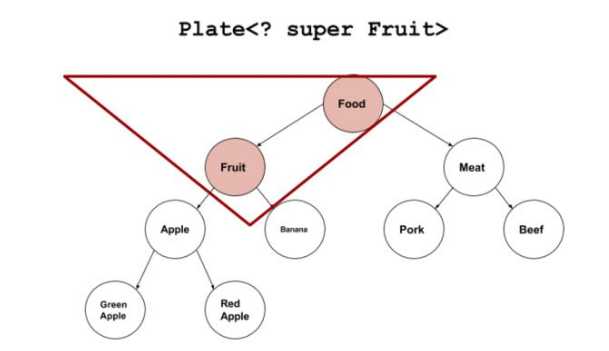Java泛型
Posted lukelook
tags:
篇首语:本文由小常识网(cha138.com)小编为大家整理,主要介绍了Java泛型相关的知识,希望对你有一定的参考价值。
java 泛型详解-绝对是对泛型方法讲解最详细的,没有之一
一. 泛型概念的提出(为什么需要泛型)?
首先,我们看下下面这段简短的代码:
public class GenericTest public static void main(String[] args) List list = new ArrayList(); list.add("qqyumidi"); list.add("corn"); list.add(100); for (int i = 0; i < list.size(); i++) String name = (String) list.get(i); // 1 System.out.println("name:" + name);
定义了一个List类型的集合,先向其中加入了两个字符串类型的值,随后加入一个Integer类型的值。这是完全允许的,因为此时list默认的类型为Object类型。在之后的循环中,由于忘记了之前在list中也加入了Integer类型的值或其他编码原因,很容易出现类似于//1中的错误。因为编译阶段正常,而运行时会出现“java.lang.ClassCastException”异常。因此,导致此类错误编码过程中不易发现。
在如上的编码过程中,我们发现主要存在两个问题:
1.当我们将一个对象放入集合中,集合不会记住此对象的类型,当再次从集合中取出此对象时,改对象的编译类型变成了Object类型,但其运行时类型任然为其本身类型。
2.因此,//1处取出集合元素时需要人为的强制类型转化到具体的目标类型,且很容易出现“java.lang.ClassCastException”异常。
那么有没有什么办法可以使集合能够记住集合内元素各类型,且能够达到只要编译时不出现问题,运行时就不会出现“java.lang.ClassCastException”异常呢?答案就是使用泛型。
二.什么是泛型?
泛型,即“参数化类型”。一提到参数,最熟悉的就是定义方法时有形参,然后调用此方法时传递实参。那么参数化类型怎么理解呢?顾名思义,就是将类型由原来的具体的类型参数化,类似于方法中的变量参数,此时类型也定义成参数形式(可以称之为类型形参),然后在使用/调用时传入具体的类型(类型实参)。
看着好像有点复杂,首先我们看下上面那个例子采用泛型的写法。
public class GenericTest public static void main(String[] args) /* List list = new ArrayList(); list.add("qqyumidi"); list.add("corn"); list.add(100); */ List<String> list = new ArrayList<String>(); list.add("qqyumidi"); list.add("corn"); //list.add(100); // 1 提示编译错误 for (int i = 0; i < list.size(); i++) String name = list.get(i); // 2 System.out.println("name:" + name);
采用泛型写法后,在//1处想加入一个Integer类型的对象时会出现编译错误,通过List<String>,直接限定了list集合中只能含有String类型的元素,从而在//2处无须进行强制类型转换,因为此时,集合能够记住元素的类型信息,编译器已经能够确认它是String类型了。
结合上面的泛型定义,我们知道在List<String>中,String是类型实参,也就是说,相应的List接口中肯定含有类型形参。且get()方法的返回结果也直接是此形参类型(也就是对应的传入的类型实参)。下面就来看看List接口的的具体定义:
public interface List<E> extends Collection<E> int size(); boolean isEmpty(); boolean contains(Object o); Iterator<E> iterator(); Object[] toArray(); <T> T[] toArray(T[] a); boolean add(E e); boolean remove(Object o); boolean containsAll(Collection<?> c); boolean addAll(Collection<? extends E> c); boolean addAll(int index, Collection<? extends E> c); boolean removeAll(Collection<?> c); boolean retainAll(Collection<?> c); void clear(); boolean equals(Object o); int hashCode(); E get(int index); E set(int index, E element); void add(int index, E element); E remove(int index); int indexOf(Object o); int lastIndexOf(Object o); ListIterator<E> listIterator(); ListIterator<E> listIterator(int index); List<E> subList(int fromIndex, int toIndex);
我们可以看到,在List接口中采用泛型化定义之后,<E>中的E表示类型形参,可以接收具体的类型实参,并且此接口定义中,凡是出现E的地方均表示相同的接受自外部的类型实参。
自然的,ArrayList作为List接口的实现类,其定义形式是:
public class ArrayList<E> extends AbstractList<E> implements List<E>, RandomAccess, Cloneable, java.io.Serializable public boolean add(E e) ensureCapacityInternal(size + 1); // Increments modCount!! elementData[size++] = e; return true; public E get(int index) rangeCheck(index); checkForComodification(); return ArrayList.this.elementData(offset + index); //...省略掉其他具体的定义过程
由此,我们从源代码角度明白了为什么//1处加入Integer类型对象编译错误,且//2处get()到的类型直接就是String类型了。
三.自定义泛型接口、泛型类和泛型方法
从上面的内容中,大家已经明白了泛型的具体运作过程。也知道了接口、类和方法也都可以使用泛型去定义,以及相应的使用。是的,在具体使用时,可以分为泛型接口、泛型类和泛型方法。
自定义泛型接口、泛型类和泛型方法与上述Java源码中的List、ArrayList类似。如下,我们看一个最简单的泛型类和方法定义:
public class GenericTest public static void main(String[] args) Box<String> name = new Box<String>("corn"); System.out.println("name:" + name.getData()); class Box<T> private T data; public Box() public Box(T data) this.data = data; public T getData() return data;
在泛型接口、泛型类和泛型方法的定义过程中,我们常见的如T、E、K、V等形式的参数常用于表示泛型形参,由于接收来自外部使用时候传入的类型实参。那么对于不同传入的类型实参,生成的相应对象实例的类型是不是一样的呢?
public class GenericTest public static void main(String[] args) Box<String> name = new Box<String>("corn"); Box<Integer> age = new Box<Integer>(712); System.out.println("name class:" + name.getClass()); // com.qqyumidi.Box System.out.println("age class:" + age.getClass()); // com.qqyumidi.Box System.out.println(name.getClass() == age.getClass()); // true
由此,我们发现,在使用泛型类时,虽然传入了不同的泛型实参,但并没有真正意义上生成不同的类型,传入不同泛型实参的泛型类在内存上只有一个,即还是原来的最基本的类型(本实例中为Box),当然,在逻辑上我们可以理解成多个不同的泛型类型。
究其原因,在于Java中的泛型这一概念提出的目的,导致其只是作用于代码编译阶段,在编译过程中,对于正确检验泛型结果后,会将泛型的相关信息擦出,也就是说,成功编译过后的class文件中是不包含任何泛型信息的。泛型信息不会进入到运行时阶段。
对此总结成一句话:泛型类型在逻辑上看以看成是多个不同的类型,实际上都是相同的基本类型。
四.类型通配符
接着上面的结论,我们知道,Box<Number>和Box<Integer>实际上都是Box类型,现在需要继续探讨一个问题,那么在逻辑上,类似于Box<Number>和Box<Integer>是否可以看成具有父子关系的泛型类型呢?
为了弄清这个问题,我们继续看下下面这个例子:
public class GenericTest public static void main(String[] args) Box<Number> name = new Box<Number>(99); Box<Integer> age = new Box<Integer>(712); getData(name); //The method getData(Box<Number>) in the type GenericTest is //not applicable for the arguments (Box<Integer>) getData(age); // 1 public static void getData(Box<Number> data) System.out.println("data :" + data.getData());
我们发现,在代码//1处出现了错误提示信息:The method getData(Box<Number>) in the t ype GenericTest is not applicable for the arguments (Box<Integer>)。显然,通过提示信息,我们知道Box<Number>在逻辑上不能视为Box<Integer>的父类。那么,原因何在呢?
public class GenericTest public static void main(String[] args) Box<Integer> a = new Box<Integer>(712); Box<Number> b = a; // 1 Box<Float> f = new Box<Float>(3.14f); b.setData(f); // 2 public static void getData(Box<Number> data) System.out.println("data :" + data.getData()); class Box<T> private T data; public Box() public Box(T data) setData(data); public T getData() return data; public void setData(T data) this.data = data;
这个例子中,显然//1和//2处肯定会出现错误提示的。在此我们可以使用反证法来进行说明。
假设Box<Number>在逻辑上可以视为Box<Integer>的父类,那么//1和//2处将不会有错误提示了,那么问题就出来了,通过getData()方法取出数据时到底是什么类型呢?Integer? Float? 还是Number?且由于在编程过程中的顺序不可控性,导致在必要的时候必须要进行类型判断,且进行强制类型转换。显然,这与泛型的理念矛盾,因此,在逻辑上Box<Number>不能视为Box<Integer>的父类。
好,那我们回过头来继续看“类型通配符”中的第一个例子,我们知道其具体的错误提示的深层次原因了。那么如何解决呢?总部能再定义一个新的函数吧。这和Java中的多态理念显然是违背的,因此,我们需要一个在逻辑上可以用来表示同时是Box<Integer>和Box<Number>的父类的一个引用类型,由此,类型通配符应运而生。
类型通配符一般是使用 ? 代替具体的类型实参。注意了,此处是类型实参,而不是类型形参!且Box<?>在逻辑上是Box<Integer>、Box<Number>...等所有Box<具体类型实参>的父类。由此,我们依然可以定义泛型方法,来完成此类需求。
public class GenericTest public static void main(String[] args) Box<String> name = new Box<String>("corn"); Box<Integer> age = new Box<Integer>(712); Box<Number> number = new Box<Number>(314); getData(name); getData(age); getData(number); public static void getData(Box<?> data) System.out.println("data :" + data.getData());
有时候,我们还可能听到类型通配符上限和类型通配符下限。具体有是怎么样的呢?
在上面的例子中,如果需要定义一个功能类似于getData()的方法,但对类型实参又有进一步的限制:只能是Number类及其子类。此时,需要用到类型通配符上限。
public class GenericTest public static void main(String[] args) Box<String> name = new Box<String>("corn"); Box<Integer> age = new Box<Integer>(712); Box<Number> number = new Box<Number>(314); getData(name); getData(age); getData(number); //getUpperNumberData(name); // 1 getUpperNumberData(age); // 2 getUpperNumberData(number); // 3 public static void getData(Box<?> data) System.out.println("data :" + data.getData()); public static void getUpperNumberData(Box<? extends Number> data) System.out.println("data :" + data.getData());
此时,显然,在代码//1处调用将出现错误提示,而//2 //3处调用正常。
类型通配符上限通过形如Box<? extends Number>形式定义,相对应的,类型通配符下限为Box<? super Number>形式,其含义与类型通配符上限正好相反,在此不作过多阐述了。
上界通配符 “Plate<? extends Fruit>” 覆盖下图中蓝色的区域

Plate<? super Fruit>覆盖下图中红色的区域。

以上是关于Java泛型的主要内容,如果未能解决你的问题,请参考以下文章